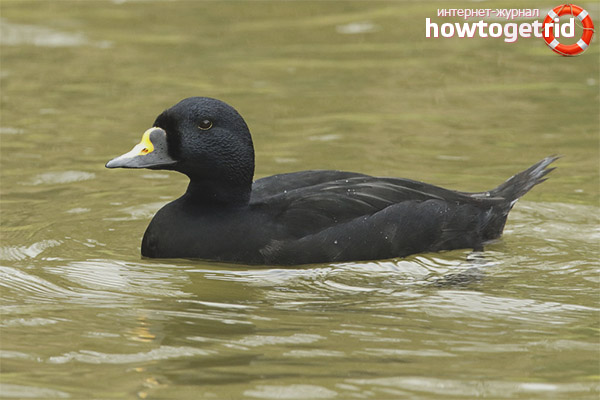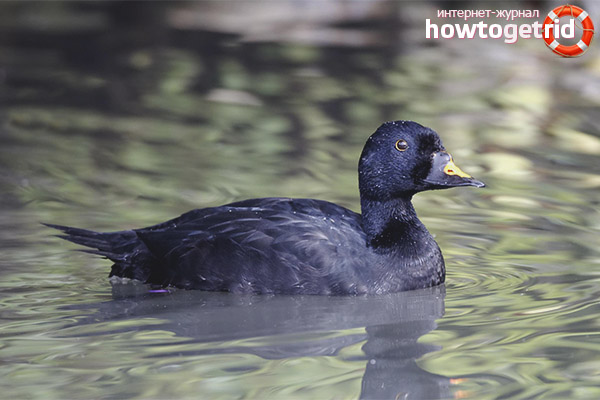The content of the article
All waterfowl deserve special attention. To date, diving birds belonging to the duck family are especially popular. We consider the blue singa, which is also called the black turpan due to specific external data. Individuals of this group live in different parts of the world, but most of them are concentrated in European countries. We will not run ahead and lay out all the cards so that below you can familiarize yourself with the most detailed description of the family representatives.
Description
- Discussed diving ducks are considered to be a group of geese. Singa is understood as a bird, average in overall features. In size, it reaches 55 cm. As for body weight, it is about 1.5 kg. The wingspan of individuals of this breed group reaches 94 cm.
- It has already been mentioned that birds are called black turpan. When the mating season begins, the male sex becomes black plumage, and on the wings there are light fringes. The head is brownish in color with gray spots, the lower part is whitish with gray.
- The beak is flat, expanded in the main part, there is a characteristic growth. It is painted in most cases black, a speck of yellow is noted. The area above the beak is yellow, but not completely. The beak has an interesting dark border.
- The male is not as bright during the mating season as when he begins to care for the female. In summer, its plumage is brown in hue, and a bright spot on its beak dims and hardly stands out.
- As for the female, she is brown, but in the direction of the dark. In this case, the pattern is scaly and light. There is a circle of dark tone on the head. The cheeks, the lower part of the body, as well as the neck in the area of the goiter are light. The sections under the wings are darker than the rest of the plumage.
- In individuals of two genders, paws of the same shade, that is, a dirty brownish-red tone. The tail has long wedge-shaped feathers, which are distinguished by their stiffness. When the bird swims in the water, it spreads its tail and proudly lengthens the neck.
- To reveal that this particular representative of the family is in front of you, and not its related species, just look at the wings. There are no bands on them that are called a mirror.
- Chicks are covered with feathers, brownish or gray in shade. The babies have areas of light tone, these are the cheeks, the lower section of the brisket, and the neck.
Spread
Birds of the family under discussion are found in Western Europe, in the vastness of our homeland. Since the birds are migratory, they do not linger for a long time.
Winters go to the expanses of the Mediterranean Sea. Meet individuals on the coasts of Italy, France and Spain. They also live in Morocco and the Atlantic. At the winter quarters of these birds can be found in the North and Baltic Sea. If weather conditions are unfavorable, birds can be found in Korea, China, and Japan.
As for the habitat, individuals prefer the tundra, forest belt and steppe terrain. They always try to settle on small water sources, whether it be closed lakes or a moss swamp. You can also find birds in small rivers, because they do not like fast-flowing springs.
Breeding
- Singings are representatives of monogamous birds. Their breeding season begins after they survive two winters. Therefore, they reach puberty at the age of at least 2 years.Nesting sites are often located near water bodies.
- In rare cases, it can slowly flowing rivers, tundra and forest outskirts. As a building material, individuals use their own fluff and dried plants. In one clutch, the female is able to bring up to 9 eggs. The mass of each can reach up to 75 gr. However, they may have a yellowish or greenish tint.
- Only the female is engaged in the offspring. The procedure lasts throughout the month. If the female needs to leave the nest, she always covers the eggs with a layer of fluff. Males under no circumstances hatch offspring. They leave their nesting sites in mid-summer.
- As soon as the drakes return to their usual habitats, they begin to molt. In such a period, birds are simply unable to fly. As for the chicks, after their appearance, they almost immediately follow their mother to the reservoir. The color of the young is similar to the mother, only a little lighter.
- As soon as the chicks are more than 1.5 months old, they become completely independent. Only the first time they still try to swim in flocks. In the wild, the individuals under consideration live up to 15 years without any problems.
Interesting Facts
- As soon as the nesting period of individuals ends, the birds in question gather in flocks. After that, they settle in the colonies with the common eider or with other turpans. Food is collected in small flocks.
- Singas swim and dive well. When moving underwater, they use wings. They may not surface to the surface for up to 1 minute. As for land movements, ducks do it extremely awkwardly. The legs are set specifically and are not adapted to movement on the ground.
- Such paws with membranes will be just the way during swimming. As for the take-off from the surface of the water, the singing do it hard and extremely reluctant. Over the water ducks fly in the form of a wedge extremely quickly and very low.
The considered individuals have unique characteristic features. It is worth noting that such birds arrive at the nesting places quite late. During the mating season, the males make very loud and melodic sounds. As for the females, they only croak hoarsely.











Submit